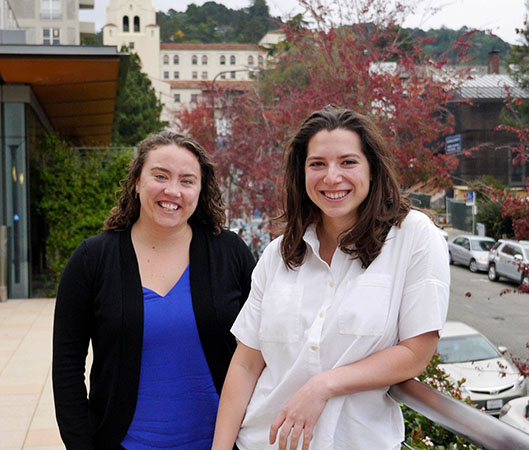Co-presidents of If/When/How: Lawyering for Reproductive Justice at Berkeley Law; research assistants with the Center on Reproductive Rights and Justice at Berkeley Law
Sam: As a politics reporter at the Huffington Post, I covered reproductive rights litigation happening all over the country. I knew I wanted to do that kind of impact litigation eventually, so I was looking for a law school where reproductive justice work was more than just a niche thing. Berkeley Law has so many connections to the reproductive rights and justice movements and leaders in that area, which was a huge reason why I wanted to come here for law school. For example, Jill Adams ’06, founded Law Students for Reproductive Justice (now called If/When/How: Lawyering for Reproductive Justice, which refers to the concept that reproductive justice will exist when every person has the right to decide if, when, and how to become a parent) as a student, then served as director of the national organization before returning to Berkeley Law to serve as executive director of the Center for Reproductive Rights and Justice (CRRJ). I had also heard before coming here that Professors Kristen Luker and Melissa Murray wrote the first casebook on reproductive rights law.
Maureen: I worked at Physicians for Reproductive Health, an organization that works to improve access to comprehensive reproductive health care. I helped our doctors do reproductive rights advocacy, such as lobbying and legislative work in their local governments. I was also on the board of directors of the New York Abortion Access Fund and am currently on the board of the National Network of Abortion Funds. This has been my work and passion for a long time. I never thought I’d go to law school—I’m on the older side of law students here—but after years of policy work I felt like I could make more of an impact as a lawyer.
One thing that’s really special about Berkeley Law is that there’s a pretty clear reproductive justice path you can take: As a 1L you can become an If/When/How member and join the Reproductive Justice Project (RJP); 2L year you can run for a leadership position with If/When/How or RJP, and become a research assistant for CRRJ; 3L year you can do a semester in the UCDC program working with a nonprofit in Washington, DC, or do an externship with any number of organizations doing this work in the Bay Area.
Sam: We’re lucky to have the national chapter of If/When/How located nearby (in Oakland). So, we’ve been able to do a lot of really timely events with their support. When Jane Doe, an undocumented teenager in Texas, couldn’t get an abortion because the Trump administration was barring her from leaving an ICE detention facility, we co-hosted an event with the Women of Color Collective and La Raza Law Students Association on the connection between immigration justice and reproductive justice. The whole room was packed, there wasn’t a seat open. It felt really good to be able to bring in different practitioners who are working on this intersection at the same time as Jane Doe’s case was unfolding.
Maureen: Sam and I are also CRRJ interns. The way CRRJ defines reproductive justice in a broad sense brings a lot more people to the table — you get people working to end restrictions on welfare, people doing criminal justice reform, and others who wouldn’t be strictly considered doing reproductive rights work. We helped with the Center’s recent fifth anniversary symposium. CRRJ is really well respected in the field, so they were able to bring together a who’s who of academics, lawyers, and activists from across the spectrum of the reproductive rights, health and justice movements. It was such a privilege for us to be a part of it.
Sam: Seeing the way CRRJ goes about doing its work and going to this conference and meeting practitioners from so many different backgrounds has really expanded my conception of the range of possible careers in this area of the law.
